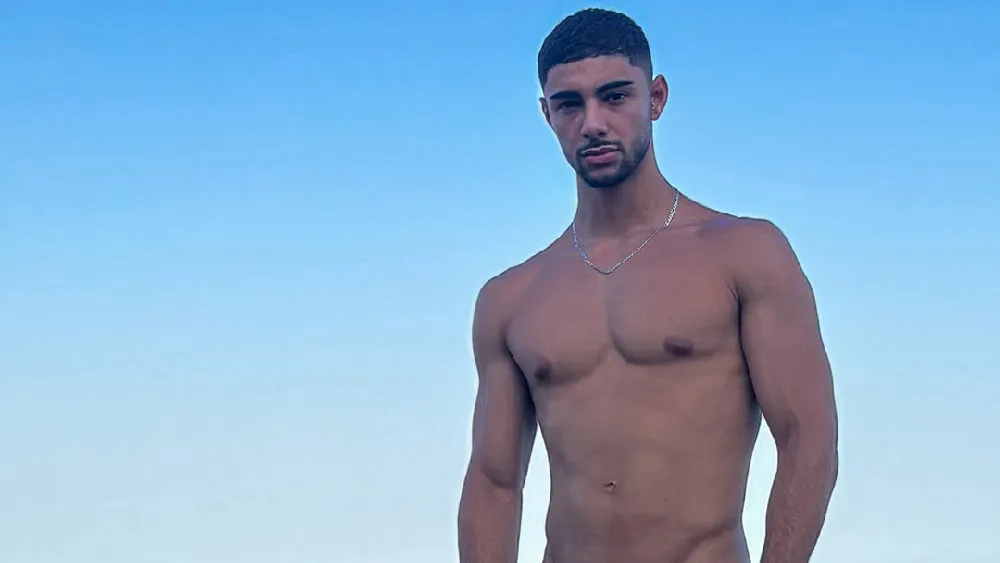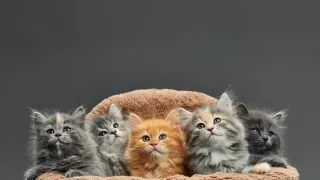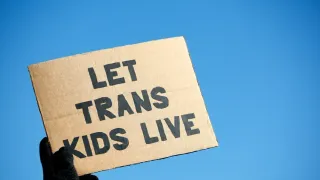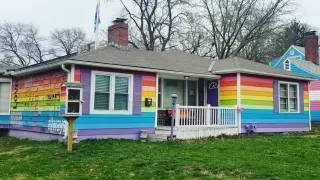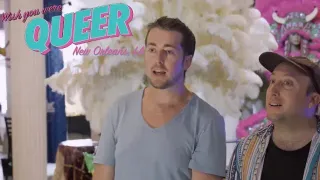October 9, 2016
'The Soundsuits Are My Drag'
Sura Wood READ TIME: 4 MIN.
The New York Times has opined that the singular creations of Nick Cave "fall squarely under the heading of 'Must Be Seen to Be Believed,'" a description that certainly applies to the gay Chicago-based artist's delightfully outrageous, nearly full-body "Soundsuits," wearable sculptures named for the racket they produce when worn while performing or generally making a spectacle of oneself.
Cave, 57, who once trained with the Alvin Ailey American Dance Theater and is currently director of the graduate fashion program at the School of the Art Institute of Chicago, can do wonders with sock monkeys, old fisherman sweaters, pipe cleaners, insanely brightly colored fabrics and a profusion of buttons, bugle beads, sequins and glitter that would make a disco queen blush.
His prototype suit was born in the early 1990s when he retrieved a passel of twigs from the woods and fashioned a cross between a woolly mammoth and "The Thing," a hybrid creature with thick, fuzzy legs and padded feet resembling brownish shag-rug samples. Once Cave put it on and noticed that it rustled like wind gusting through the trees, he had met his medium. Since then, he has made hundreds of the suits, which can sell for upwards of $180K.
Dan Cameron, writing about Cave's eclectic references in a catalogue essay for a YBCA show of the artist's work a few years ago, cites "the social sculpture of the artist Joseph Beuys, the legacy of the drag queen Leigh Bowery in the London underground performance scene and the ornate costumes of African-American Mardi Gras Indians in New Orleans." Add to that a dash of Andy Warhol, the kinky punk of Vivienne Westwood, the wildness of the late Alexander McQueen, African tribal regalia and a component of irrepressible joy.
Cave and I spoke recently while he was in the midst of preparing for "Until," an immense new installation, opening Oct. 15, at the Massachusetts Museum of Contemporary Art, noteworthy for its focus on the pressing topic of race and gun violence and the absence of his signature Soundsuits, except for one, a full-on chicken mask worn by Cave in a short video. Closer to home, an assortment of the suits and performance videos are on display at the Anderson Collection on the Stanford University campus through Aug. 14, 2017. What follows are edited excerpts of our conversation.
Sura Wood: I think of your Soundsuits as great equalizers, erasing traces of class, race and gender. It's a concept that seems especially relevant right now.
Nick Cave: Does it ever! There's this sublime undercurrent in the work that's always been there, built around identity, race and class, emanating from compassion. How do I lead you into these strong political issues? With the Soundsuits, before you know it, you're engaged.
Do you think of the Soundsuits as moving collages?
I see them as sculptures that are assemblages. My work sits between fashion, design and art, but whether it's through video, performance or installation, the body is the central core. What inspires me is what's currently going on in the world, be it political or what's coming down the runway.
What's an example of an image or idea that sparked one of your creations?
I discovered a round, wooden-framed sifter with a mesh screen at a flea market. I took that object, moved it around the body and then did a loose sketch. The mesh become wire and bugle beads, and the rest of the suit was covered in buttons. I found the shape for it by looking at the ductwork in the ceiling.
You've said the impetus for the Soundsuits emerged in the aftermath of the Rodney King incident in 1992.
It was a time when I was questioning my own identity as a black man and disturbed by being profiled whenever I'd leave the privacy of my home. When I was in the park and saw this twig on the ground, the first thoughts that came to mind were of being discarded, dismissed, viewed as "less than." I collected the twigs and started to build what I thought was a sculpture, but the moment I put it on and moved in it, the Soundsuit was born. It was like armor. I was able to protect and disguise my identity, while presenting something bigger, disturbing yet seductive.
What role has your gay identity played in your art?
I think it's expressed through adornment and embellishment and the opulence of the work, in my interest in how we dress and decorate ourselves in a celebratory way, the grandeur of presentation. It's about accepting oneself, being bold and strong, standing up for what's right without boundaries. The Soundsuits are my drag.
If we were peeking inside your clothes closet, what might we see?
You'd see pretty much all black. I like timeless things that aren't trend-based, but timeless doesn't mean classic. I'm interested in amazing fabrics, and I love great shoes. I have an amazing collection of sneakers, a lot of Rick Owens, Comme des Garcons, Issey Miyake. I like to mix it up. I may put on a Comme des Garcons short that looks like a skirt, a McQueen sneaker with a Miyake tank top, and that's for a casual day in the studio. Even in the closet, I'm collaging and building a piece.
How does someone raised with seven brothers in a small town in Missouri by a single mother find their way into art and fashion?
My aunts were amazing seamstresses. I had uncles that were painters. There are musicians in the family. My grandfather made furniture in addition to doing construction. Both grandmothers were quilters. I watched all of this happening around me. I wasn't privileged to go out and buy materials, so I had to create art from my surroundings. I would make my mother macrame purses, sandals and haltertops; even then, the macrame bag was the ultimate bag. But I was also doing football, basketball, baseball, all of it.
And crocheting at home? You were leading a double life?
Yes, and I'm glad I had all those options so I could choose what interested me later in life.
You're most readily identified with the Soundsuits, but are you tired of them?
I think the project at MASS MoCA is going to set a different stage for me. There are other things I want to do, but I'll always make some. A chapter never closes.
